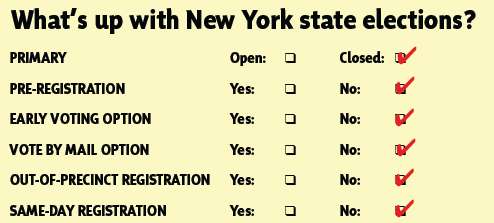Allegro
Closed Primaries, Shut Out Voters
Does New York’s primary system need an overhaul?
Volume 116, No. 6June, 2016

Christopher Carroll
April 19 came and went, and with it passed New York State’s presidential primary. Former Secretary of State Hillary Clinton collected 139 of 247 delegates, and real estate mogul Donald Trump secured 89 of 95 delegates. Though both results had a significant – though not transformational – impact on each candidate’s momentum during the presidential primary season, far more important was the fallout of the apparent failure of the voting process. 126,000 voters were inexplicably purged from voter rolls in Brooklyn, prompting investigations by NYC Comptroller Scott Stringer and New York Attorney General Eric Schneiderman. Regardless of whether this was a result of inept management or malicious intent, this was a massive failure of our election system.
But is New York’s electoral system already broken? Is our process and structure doomed to failure from the start? New York, a state that purports to be progressive, equitable and inclusive, has some of the most restrictive election laws in the entire country.
Like 27 other states, New York holds closed primaries, meaning prospective voters may participate on primary election day only if they are registered members of a party. This system, advocates argue, is best in a primary, as it allows state parties to preserve the integrity of the party’s selection by preventing “crossover” voters from adversely impacting election outcomes.
Critics, meanwhile, argue that the system contributes to the polarization of the primary cycle, forcing candidates to pander to the more extreme or hard-line members of their base in order to win their party’s nomination. Meanwhile, independent voters – who could potentially inject some moderate or mainstream influence – are left out.
While both these arguments have some valid points, the closed primary system has an additional negative impact: it contributes to voter disenfranchisement.
This April, 3.2 million New Yorkers not registered in one of the two major parties were not able to vote. How is this possible? New York State is one of the most difficult places to participate in a primary election. This isn’t due to extreme voter I.D. laws like those that have been enacted across the country following the Supreme Court’s repealing of the Voting Rights Act in 2013. This is instead due to the state’s use of a closed primary system with registration deadlines far in advance of election day. These two policies, when combined and then augmented by a number of other factors, have led the Center for American Progress to rank New York 44th on the “Health of State Democracies” index, which includes a grade of D- for accessibility to the ballot.

Many New Yorkers pride themselves on living in a liberal, progressive state. But in reality, unreasonable registration deadlines in New York can actually hinder the democratic process.
VOTERS LEFT BEHIND
New York State requires voters to register further in advance than many states, especially if changing party affiliation.
If not previously registered, a New Yorker wishing to vote in the primaries on April 19 would have had to do so by March 25, more than three weeks before the election and before major candidates had started campaigning in earnest across the state. But these non-registered voters were actually lucky when compared to New Yorkers registered as independent or unaffiliated.
Switching party affiliation is extremely difficult in New York. To do so, registered voters had to file paperwork by Oct. 9, 2015 – half a year before the presidential primary, eight months before the Congressional primary, and nearly 11 months before the local/state primaries! How could anyone have predicted last October that Donald Trump would be a viable candidate or that Bernie Sanders would still be in the race? Who knows who might be running in local elections in September? As a result, millions of people who only recently became engaged, interested and active in the 2016 primary cycle were unable to voice their opinion and determine a major party nominee.
MOVING FORWARD
It’s time to re-examine our election system and the requirements placed upon voters. The arguments in favor of closed primaries admittedly have some merit. But when closed primaries are paired with registration deadlines that are extraordinarily far in advance of election day, the result is an overly burdensome process for voters, resulting in the suppression of votes.
Governor Cuomo, in his 2016 state-of-the-state address, called for election reform, suggesting that the health and effectiveness of our government relies on engaging people in the democratic process. “Voter registration should be a presumption, not a hurdle,” stated the governor. Pushing well beyond changing registration deadlines and open vs. closed primaries, Gov. Cuomo recommended automatic registration when voters get a drivers license. Oregon and California have already taken this step, greatly expanding the number of people who are eligible to participate in democratic elections. The fact of the matter is, a state that Gallup claims is the fourth most liberal in the country should be among the leaders in voter access. New York must be a state that goes out of its way to encourage participation, not indifference or voter suppression. Holding three separate primaries already encourages low turnouts by reducing the importance of each election (while increasing the cost to the state). If New Yorkers truly value a closed primary system, then let’s make switching party affiliation easier. If we want to be a state that encourages voter participation, let’s allow for same-day registration on election day. If we want New Yorkers to be active in their communities, advocates for their values and champions of democracy, let’s make it as easy to vote and as easy to participate as possible.
New York talks the liberal and progressive talk, but it’s time for our citizens, elected officials and leaders to walk the walk. Voter participation should be one of the New York values that we’re so proud of.
